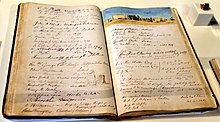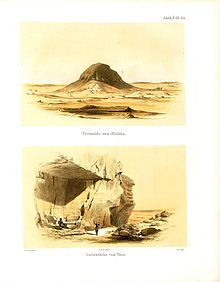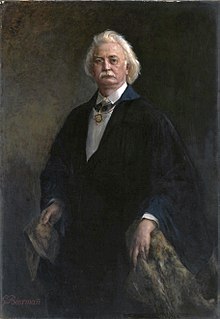Karl Richard Lepsius
This article has multiple issues.Please helpimprove itor discuss these issues on thetalk page.(Learn how and when to remove these template messages)
|
Karl Richard Lepsius | |
|---|---|
 Lepsius in 1874 | |
| Born | 23 December 1810 |
| Died | 10 July 1884(aged 73) Berlin,Province of Brandenburg |
| Nationality | Prussian,German |
| Alma mater | Leipzig University,University of Göttingen,University of Berlin |
| Known for | Denkmäler aus Ägypten und Äthiopien |
| Spouse |
Elisabeth Klein (m.1846) |
| Children | 6 |
| Relatives | Bernhard Klein(father-in-law) |
| Awards | Royal Gold Medal |
| Scientific career | |
| Fields | Egyptology |
| Institutions | University of Berlin |
| Signature | |
 | |
Karl Richard Lepsius(Latin:Carolus Richardius Lepsius) (23 December 1810 – 10 July 1884) was aPrussianEgyptologist,linguistandmodern archaeologist.[1]
He is widely known for his opus magnumDenkmäler aus Ägypten und Äthiopien.
Early life[edit]
Karl Richard Lepsius was the son ofKarl Peter Lepsius,aclassical scholarfrom Naumburg, and his wife Friederike (née Gläser), who was the daughter of composerCarl Ludwig Traugott Gläser.[2]The family name was originally "Leps" and had beenLatinizedto "Lepsius" by Karl's paternal great-grandfather Peter Christoph Lepsius.[3]He was born inNaumburg on the Saale,Saxony.[4]
He studied Greek and Romanarchaeologyat theUniversity of Leipzig(1829–1830), theUniversity of Göttingen(1830–1832), and theFrederick William University of Berlin(1832–1833). After receiving his doctorate following his dissertationDe tabulis Eugubinisin 1833, he travelled toParis,where he attended lectures by the French classicistJean Letronne,an early disciple ofJean-François Champollionand his work on thedeciphermentof theEgyptian language,visited Egyptian collections all over Europe and studiedlithographyandengraving.
Work[edit]


After the death of Champollion, Lepsius made a systematic study of the French scholar'sGrammaire égyptienne,which had been published posthumously in 1836 but had yet to be widely accepted. In that year, Lepsius travelled toTuscanyto meet withIppolito Rosellini,who had led a joint expedition to Egypt with Champollion in 1828–1829. In a series of letters to Rosellini, Lepsius expanded on Champollion's explanation of the use of phonetic signs inhieroglyphicwriting, emphasizing (contraChampollion) thatvowelswere not written.
Denkmäler[edit]
In 1842, Lepsius was commissioned (at the recommendation of the minister of instruction, Johann Eichhorn, and the scientistsAlexander von HumboldtandChristian Charles Josias Bunsen) by KingFrederich Wilhelm IVofPrussiato lead an expedition toEgyptand theSudanto explore and record the remains of theancient Egyptiancivilization. The Prussian expedition was modelled after the earlier Napoleonic mission, with surveyors, draftsmen, and other specialists.[5]The mission reachedGizain November 1842 and spent six months making some of the first scientific studies of thepyramidsof Giza,Abusir,Saqqara,andDahshur.They discovered 67 pyramids recorded in the pioneeringLepsius list of pyramidsand more than 130 tombs of noblemen in the area.[5]While at theGreat Pyramid of Giza,Lepsius inscribed agraffitowritten in Egyptian hieroglyphs that honours Friedrich Wilhelm IV above the pyramid's original entrance; it is still visible.[6]

Working south, stopping for extended periods at important Middle Egyptian sites, such asBeni HasanandDayr al-Barsha.In 1843, he visited sites inNubiasuch asJebel Barkal,MeroëandNaqa,ruined ancient cities of theKushitic Kingdomof Meroë, and copied some of the inscriptions and representations of the temples and pyramids there.[7]
Lepsius reached as far south asKhartoum,and then travelled up theBlue Nileto the region aboutSennar,[citation needed]where he met members of the former Sudanese royal family, such asNasra bint 'Adlan.[8]After exploring various sites in Upper and LowerNubia,the expedition worked back north, reachingThebeson November 2, 1844, where they spent four months studying the western bank of the Nile (such as theRamesseum,Medinet Habu,theValley of the Kings,etc.) and another three on the east bank at the temples ofKarnakandLuxor,attempting to record as much as possible. Afterwards they stopped atCoptos,theSinai,and sites in theEgyptian Delta,such asTanis,before returning to Europe in 1846.[citation needed]
In 1845, he was elected as a member to theAmerican Philosophical Society.[9]

The chief result of this expedition was the publication ofDenkmäler aus Aegypten und Aethiopien(Monuments from Egypt andEthiopia), a massive twelve volumecompendiumof nearly 900 plates of ancient Egyptian inscriptions, monuments and landscapes, as well as accompanying commentary and descriptions. These plans, maps, and drawings of temple and tomb walls remained the chief source of information for Western scholars well into the 20th century, and are useful even today as they are often the sole record of monuments that have since been destroyed or reburied.[10]For example, he described a "Headless Pyramid" that was subsequently lost until May 2008, when a team led byZahi Hawassremoved a 25-foot-high sand dune to re-discover the superstructure (base) of a pyramid believed to belong to KingMenkauhor.
Later career[edit]
Upon his return to Europe in 1845, he married Elisabeth Klein in 1846 and was appointed as a professor of Egyptology at Berlin University in the same year, and the co-director of theÄgyptisches Museumin 1855; after the death ofGiuseppe Passalacquain 1865, he was director of the museum. In 1866 Lepsius returned to Egypt, where he discovered theDecree of CanopusatTanis,an inscription closely related to theRosetta Stone,which was likewise written inEgyptian(hieroglyphicanddemotic) andGreek.
Lepsius was president of theGerman Archaeological Institutein Rome from 1867 to 1880, and from 1873 until his death in 1884, the head of theRoyal Library at Berlin.He was the editor of theZeitschrift für ägyptische Sprache und Altertumskunde,a fundamental scientific journal for the new field ofEgyptology,which remains in print to this day. While at the editorial helm, Lepsius commissionedtypographerFerdinand Theinhardt (on behalf of thePrussian Academy of Sciences) to cut the first hieroglyphictypeface,the so-called Theinhardt font, which is in use today.
Lepsius published widely in the field of Egyptology, and is considered the father of this modern scientific discipline, assuming a role that Champollion might have achieved, had he not died so young. Much of his work is fundamental to the field. Indeed, Lepsius even coined the phraseTotenbuch( "Book of the Dead"). He was also a pioneer in the field of African linguistics, though his ideas are now mainly considered to be outdated. Based on his work in the ancient Egyptian language, and his field work in the Sudan, Lepsius developed aStandard AlphabetfortransliteratingAfrican Languages;it was published 1855 and revised in 1863. His 1880Nubische Grammatik mit einer Einleitung über die Völker und Sprachen Afrika'scontains a sketch of African peoples and a classification of African languages, as well as a grammar of theNubian languages.
Family[edit]
On 5 July 1846, he married Elisabeth Klein, (1828–1899), daughter of the composerBernhard Kleinand great-granddaughter ofFriedrich Nicolai.They had six children, including the geologist and Rector of theDarmstadt University of TechnologyG. Richard Lepsius (1851–1915), the chemist and director of the Chemical Factory Griesheim Bernhard Lepsius (1854–1934), the portrait painter and member of thePrussian Academy of Arts(as of 1916)Reinhold Lepsius(1857–1929) and the youngest sonJohannes Lepsius,Protestant theologian, humanist and Orientalist.
Major works[edit]

- 1842.Das Todtenbuch der Ägypter nach dem hieroglyphischen Papyrus in Turin mit einem Vorworte zum ersten Male herausgegeben.Leipzig: Georg Wigand. (Reprinted Osnabrück: Otto Zeller Verlag, 1969)
- 1849.Denkmäler aus Ägypten und Äthiopiennach den Zeichnungen der von Seiner Majestät dem Könige von Preußen Friedrich Wilhelm IV. nach diesen Ländern gesendeten und in den Jahren 1842–1845. ausgeführten wissenschaftlichen Expedition auf Befehl Seiner Majestät herausgegeben und erläutert.13 vols. Berlin: Nicolaische Buchhandlung. (OCLC1072504946) (Reprinted Genève: Éditions de Belles-Lettres, 1972 -OCLC857205)
- 1852.Briefe aus Aegypten, Aethiopien und der Halbinsel des Sinai geschrieben in den Jahren 1842–1845 während der auf Befehl Sr. Majestät des Königs Friedrich Wilhelm IV von Preußen ausgeführten wissenschaftlichen Expedition.Berlin: Verlag von Wilhelm Hertz (Bessersche Buchhandlung). Translated into English 1853Discoveries in Egypt, Ethiopia and the Peninsula of Sinai.London: Richard Bentley. (Reissued byCambridge University Press,2010.ISBN978-1-108-01711-4)
- 1855.Das allgemeine linguistische Alphabet. Grundsätze der Übertragung fremder Schriftsysteme und bisher noch ungeschriebener Sprachen in europäische Buchstaben.Berlin: Verlag von Wilhelm Hertz (Bessersche Buchhandlung)
- 1856.Über die XXII. ägyptische Königsdynastie nebst einigen Bemerkungen zu der XXVI. und andern Dynastieen des neuen Reichs.Berlin: Gedruckt in der Druckerei der königl. Akademie der WissenschaftenInternet Archive.Translated into English 1858:The XXII Egyptian Royal Dynasty, with some remarks on the XXIV and other Dynasties of the New Kingdom.London: John Murray (Republished byCambridge University Press,2010.ISBN978-1-108-01739-8)
- 1860. The Gospel of Mark in the Fiadidja dialect of Nubian also called theNobiin language.Published in Berlin in 1860. Then edited by Leo Reinisch, and republished by theBritish and Foreign Bible Societyin 1885.
- 1863.Standard Alphabet for Reducing Unwritten Languages and Foreign Graphic Systems to a Uniform Orthography in European Letters,2nd edition, London/Berlin. (Republished byJohn Benjamins,1981. With an introduction by J. Alan Kemp.doi:10.1075/acil.5)
- 1880.Nubische Grammatik mit einer Einleitung über die Völker und Sprachen Afrika's.Berlin: Verlag von Wilhelm Hertz
Death[edit]
He hadstomach ulcerswhich became cancerous. After five weeks of eating little, he died at 9 am on 10 July 1884.[11]
See also[edit]
References[edit]
- Citations
- ^Hayen, Todd (2016-12-19).Ancient Egypt and Modern Psychotherapy: Sacred Science and the Search for Soul.Routledge. p. 46.ISBN978-1-317-30747-1.
- ^Lepsius 1854,pp. 9–10.
- ^Lepsius 1854,p. 9.
- ^Lepsius 1993,p. 316.
- ^abPeck 2001,p. 289.
- ^Orcutt, Larry (2002)."GP Hieroglyphics".Retrieved18 February2005.
- ^Clammer 2005,pp. 128–31.
- ^Lepsius, Richard (1853).Letters from Egypt, Ethiopia, and the Peninsula of Sinai.H.G. Bohn. pp. 176–180.
- ^"APS Member History".search.amphilsoc.org.Retrieved2021-04-12.
- ^"Denkmaeler aus Aegypten und Aethiopien".library.si.edu.2015.Retrieved2021-06-29.
- ^Ebers 1887,p. 280-81.
Sources[edit]
- Clammer (2005).Sudan.Bradt Travel Guides.ISBN978-1-84162-114-2.
- Ebers, Georg (1887).Richard Lepsius; a biography.Translated byUnderhill, Zoe Dana.New York: William S. Gottsberger.
- Lepsius, Karl Peter (1854).Kleine Schriften: Beiträge zur thüringisch-sächsischen Geschichte und deutschen Kunst- und Alterthumskunde(in German). Vol. 1st Vol. R. Kretschmann. Magdeburg: Albert Schulz.
- Lepsius, Mario Rainer (1993).Demokratie in Deutschland: soziologisch-historische Konstellationsanalysen: ausgewählte Aufsätze.Vol. 100. Göttingen: Vandenhoeck & Ruprecht.ISBN3-525-35763-X.
- Peck, William H. (2001). "Lepsius, Karl Richard". InRedford, Donald B.(ed.).The Oxford Encyclopedia of Ancient Egypt, Volume 2.Oxford University Press. pp. 289–290.ISBN978-0-19-510234-5.
Further reading[edit]
- Wilkinson, Toby (2020).A World Beneath the Sands: Adventurers and Archaeologists in the Golden Age of Egyptology(Hardbook). London: Picador.ISBN978-1-5098-5870-5.
External links[edit]
- Works by or about Karl Richard LepsiusatInternet Archive
- Chisholm, Hugh,ed. (1911)..Encyclopædia Britannica.Vol. 16 (11th ed.). Cambridge University Press. p. 481.
- Lepsius ArchivArchived2011-07-18 at theWayback Machine:archival material from Lepsius' 1842–1845 expedition toEgyptandNubia
- Lepsius Project:Denkmäler aus Aegypten und Aethiopien:Lepsius' 12 volume masterwork on the inscriptions ofancient EgyptandNubia;still useful today
- 1810 births
- 1884 deaths
- 19th-century German archaeologists
- 19th-century linguists
- People from Naumburg (Saale)
- People from the Kingdom of Saxony
- Linguists from Germany
- Creators of writing systems
- German Egyptologists
- Recipients of the Royal Gold Medal
- Recipients of the Pour le Mérite (civil class)
- German male non-fiction writers
- German philologists
- Linguists of Indo-Semitic languages
- Archaeologists from Saxony-Anhalt
- Tanis
- Historians from the Kingdom of Prussia
